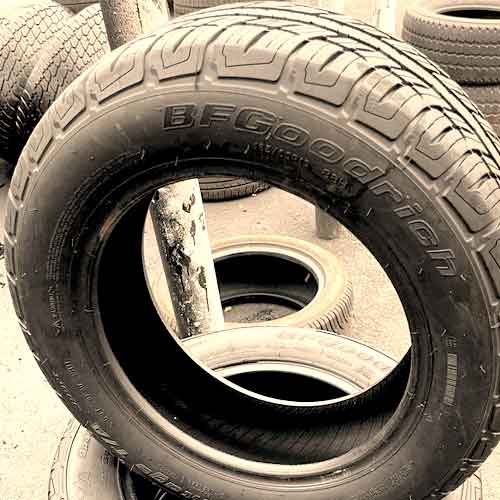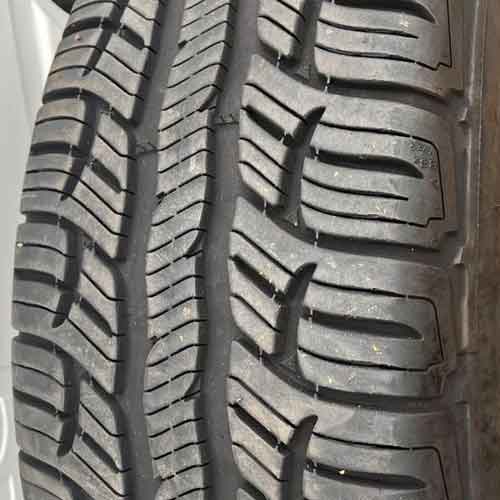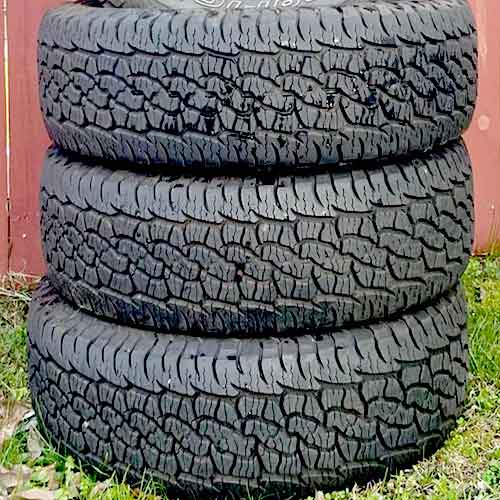Both the BF Goodrich Trail Terrain and the BFG Advantage T/A Sport are packed with such innovative tread compounds that it’s no surprise, we are seeing great performance results out of them. But there are a lot of performance metrics, and on some one does better than the other. Let’s take a closer look at my findings.

Being a tire engineer, from my perspective, the BFG Trail Terrain being more aggressive offers superior off-road traction on all types of terrains, and on roads, it offers a quieter ride. On the other side, the BFG Advantage features superior grip in both wet and dry environments, you get better comfort here, along with tread and fuel economy too.
Table of Contents
Available Sizes
The BF Goodrich Trail Terrain comes in 44 sizes in 15 to 22 inches. They have following specs.
- Speed Ratings: T and H
- Load Ratings: XL and SL
- Tread depth: 12.5/32″ on all
- Weight Range: 30 to 46 lbs
- 60k Miles warranty
On the other hand, the BF Goodrich Advantage T/A comes in 41 sizes, but in same 15 to 22 inches. And they have following specs.
- Speed Ratings: T, H and V
- Load Ratings: XL and SL
- Tread depth range: 10 to 12/32″
- Weight Range: 20 to 35 lbs
- 70,000 mile tread life warranty for T rated sizes or 60k for H and V (speed) rated sizes
Tread Design
The BF Goodrich Advantage T/A has a pretty straight forward design of narrow inner rib and bulky shoulders.

With the continuous design of the central rib, the tire focuses on the directional part of traction on dry roads, where as the numerous full depth siping (on it) provides wet gripping.
Moreover, it makes curves and have notches embedded, which face in both directions.
Surrounding the rib are wide prominent circumferential grooves which divide the fat shoulder lugs aside.
These shoulder blocks have full depth thicker siping, and “Plus-Shaped” deep notches which provide off road biting.
Though they are not staggered on the outer margins. Nor they make any sidewall lugs on them, as you must have seen at the very top of the page.
That’s because the tire is too on-road oriented to be included in the all-terrain category, unlike it’s competitor.
The BF Goodrich Trail Terrain T/A on the other side, is more aggressive.

This tire has has some seriously cool staggered shoulder blocks and slanted sidewall lugs with deep biters.
The shoulder blocks don’t divide up as seen in the other tire, instead there’s a continuous rib with traction notches all over.
These ribs (on each side) form awesome circumferential channels that set aside the central blocks.
In the middle, the compactly packed blocks have sharp offset edges and full depth siping that splits them all the way to the base, providing some serious biting power.
Although the tire doesn’t have traditional stone ejectors, it does have super cool triangular ones strategically placed in the grooves, (just like the BFG Advantage).
Winter Traction
Winter traction has a lot of variables, including different types of terrains, which include ice, on-road snow, and fluffy snow.
And considering all, I can say this without any hesitation, that both tires are, in a word, great. And you can’t really put one over the other.
BF Goodrich Trail Terrain comes with interlocking central structure, with full depth sipes (splitting open the blocks all the way down to the base).
These along with notches on the shoulder ribs grab in the snow particles and easily make snow to snow contact with them.
Similarly, the BF Goodrich Advantage T/A Sport also comes with a lot of biters and in groove notches connected to full depth siping, and they grab in the snow in a very effective way as well.
(Snow to snow contact generates greater friction, compared to rubber to snow).
Overall both tires having 3 peak mountain snowflake ratings, is fully justified.
Dry Performance
Factors that contribute to optimal performance on highways include dry grip, handling stability, and steering feedback.
Dry Grip
The directional grip depends on the middle section of the tread (as most of the weight gets concentrated there ,while rolling straight).
That’s why with a larger contact patch offering, the BF Goodrich Advantage provides better gripping values. The tire also has continuous running longitudinal rib in the very middle, which keeps the rubber to road connection consistent.
BF Goodrich Trail Terrain on the other side, can’t make up as much contact with the road, so it naturally lacks in braking distance tests (though by only 2 feet, on average).
Dry Handling
Tire handling is largely dependent on the sides of the tire, and their ability to make contact with the road.
And here although the opposite is seen (where BF Goodrich Trail Terrain gets to have continuous outer shoulders), the Advantage Sport still takes the cake, mainly because of it’s superb steering response.
BFG Advantage actually is very light in weight. I mean, comparing heaviest sizes (on both tires), it’s almost 10 pounds lighter. So it’s moving inertia is not that forceful.
This means that it’s lugs don’t want to flex, too much, as the tire turns, and this accounts for a better balance between under and over steering, and you get faster steering feedback times.
Wet Traction
Wet traction is influenced by two things, sipes and grooves.
Grooves clear off a majority of water, as it passes out through the channels, while sipes act on a micro level, sucking left-over water particles in their slits.
That’s why even though both tires feature ample sipes, the BF Goodrich Trail Terrain still lacks, due to it’s closed up outer ribs, which don’t allow water to escape out sideways. And so more of the water stays stuck behind, for the sipes to deal with, and overall wet traction gets compromised.
BF Goodrich Advantage T/A Sport on the other side, features better water evacuation, though it’s open shoulder voids, so overall things are better on this tire, even though it’s tread compound is a little bit harder.
Tread Noise
The volume of tire noise is influenced by the amount of air that passes through its tread. And most of it comes in through the shoulder voids (outer ribs of the tire).
That’s why out of both tires, even though you get a more voided structure on BF Goodrich Trail Terrain, it’s still quieter.
With continuous running shoulder rib (without any gaps in between), air is not permitted to come in and hit around the walls of the tread voids (which generates noise), with as much force, relatively.
On the flip side, the BF Goodrich Advantage T/A Sport although features a very on-road oriented structure, it’s outer tread area is still more voided, and so its not as effective in this department.
Tread Life
The tread life of a tire is influenced by factors such as tread depth, rubber compound, and rolling resistance. And considering all, it can be explained why the BFG Advantage shows better performance values.
The tire has a lighter structural weight, so it’s puts less pressure on it’s lugs, and they don’t burn off the road with as much force.
BF Goodrich Trail Terrain on the other side, features greater rolling resistance, and so it’s lugs burn off faster with the ground.
Durability
Off-road tires must be able to withstand the harsh conditions and obstacles they encounter on rough terrain. That’s why these tires are made prone to punctures and cuts to some extent, mostly from their inner construction.
Speaking of which, both tires have similar 2 ply polyester casing, 2 broad steel belts which covers the tread area, and a single ply nylon reinforcements.
Nonetheless, looking at things overall, the BF Goodrich Trail Terrain still gets an upper hand, with its thicker sidewall lugs.
Off Road Traction
Off-road tires should have strong self-cleaning abilities and durability along with a ton of biters, all these factors account for performance on different types of terrains.
To make things easier to understand, I’ve divided the following section in to those different types of lands.
On Gravel and Dirt
When driving on gravel, stones can easily get stuck in the tread of the tire, causing damage and reducing handling and directional traction.
To prevent this, off-road tires are equipped with stone ejectors that can throw out any trapped debris. Additionally, they are also given with chip-resistant rubber to prevent “significant” damage.
Both of our boys here, although don’t offer traditional stone ejectors, that you see between the shoulder lugs, they do have BF Goodrich’s special triangular shaped ones (strategically placed in the outer grooves). And they get the job done.
Though out of both , you’d see a better handling efficacy on BFG Advantage, still. This is because of it’s open outer ribs, allowing for superior dirt evacuation.
On Rocks
On rocky terrains, tires need 2 things, gripping, and durability. And considering both, its safe to say, you are better off with BF Goodrich Trail Terrain.
Although both tires come with similar inner construction, the BFG has a superior cut resistant rubber, and it’s sidewall lugs protect it form there in a better way.
Moreover, the tire with it’s interlocking central lugs, provide better gripping efficacy in all directions. This gets further improved with full depth siping, which divide these lugs further allowing for much better grip from all directions.
BF Goodrich Advantage T/A Sport on the other hand is way too less aggressive for climbing rocks, and it’s missing sidewall lugs don’t do much for it even with lowered air pressure.
Though this goes especially for the sandy terrains.
On Sand
Sand is a unique terrain that requires tires to have a large contact patch and softer compound, along with lighter weight.
All these things basically provide the tire with one thing. Digging prevention.
BF Goodrich Trail Terrain is one of the best tire to have on sand. It’s very light in weight (for an all terrain tire), and its continuous running outer ribs provide very smooth contact patch to meet up with the sand.
Furthermore, with thick sidewall lugs, that contact patch gets further enhanced, allowing for great floating abilities.
BF Goodrich Advantage T/A Sport on the other hand, although has a lighter weight in comparison, and it comes with softer outer edges as well, with missing sidewall lugs, it just can’t outperform its competitor, nonetheless.
Read More: Are A/T tires good on sand?
On Mud
On muddy terrains, a tire’s ability to clear the mud from the tread is crucial, along with its ability to scoop the ground.
And here both tires show similar results, or should I say, they are both equally bad.
BF Goodrich Trail Terrain although has interlocking tread voids in the middle, it’s packed up shoulders don’t let the mud leave out easily.
Whereas the BF Goodrich Advantage T/A Sport also has a very on-road oriented design that does the same.
Though still if you have to pick one for (mild off-road) mud terrains, I’d say go with Trail Terrain T/A, mainly because of the tire’s staggered shoulders, and sidewall lugs. They act as traction scoops, paddling the tire’s way out, throwing mud backwards, and generating forward momentum with it.
To Sum Up
BF Goodrich Trail Terrain is a more aggressive and durable tire out of the two, so its not able to do so well on smooth pavements, comparatively.
Though still let me say this that on dry roads, you won’t feel any difference between the two (meaning, its only on the paper).
And of course, the tire does great off-road in all types of terrains, except for handling on gravely roads.
BF Goodrich Advantage T/A Sport on the other side, is abetter on-road tire, in terms of all, including traction, comfort, fuel usage and tread life.
That article was good I am looking at both tires for a jeep cherokee limited and they will both work for that car and I am a big BF Goodrich fan anyway. Thanks.
– Bill
Glad you liked it.